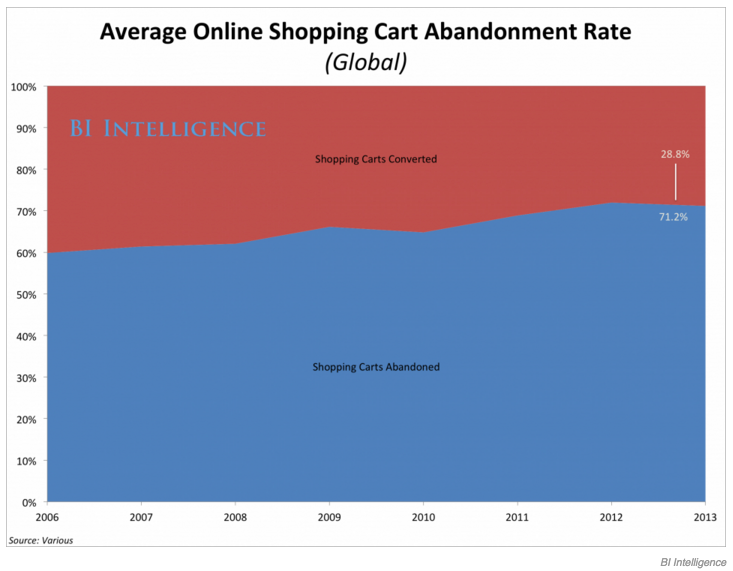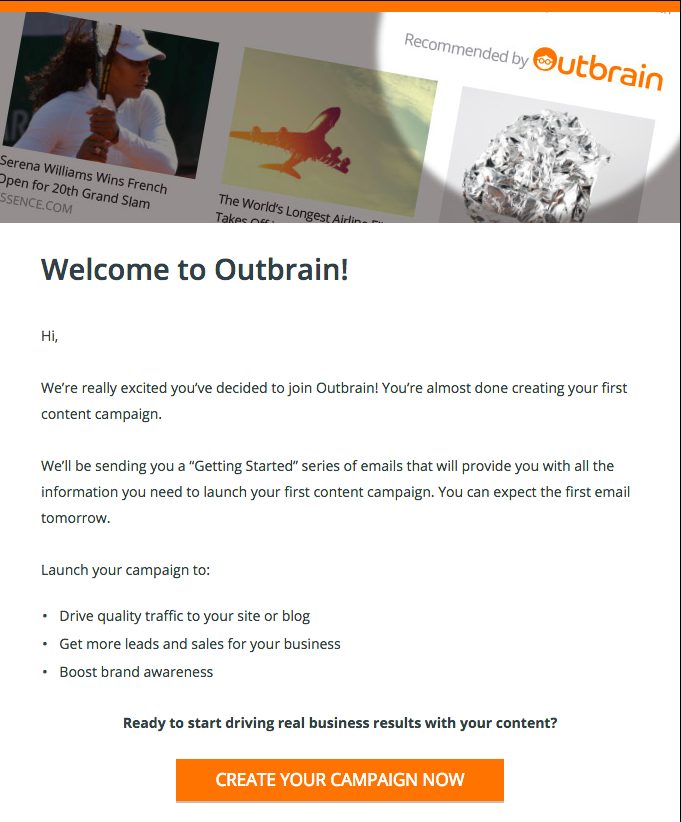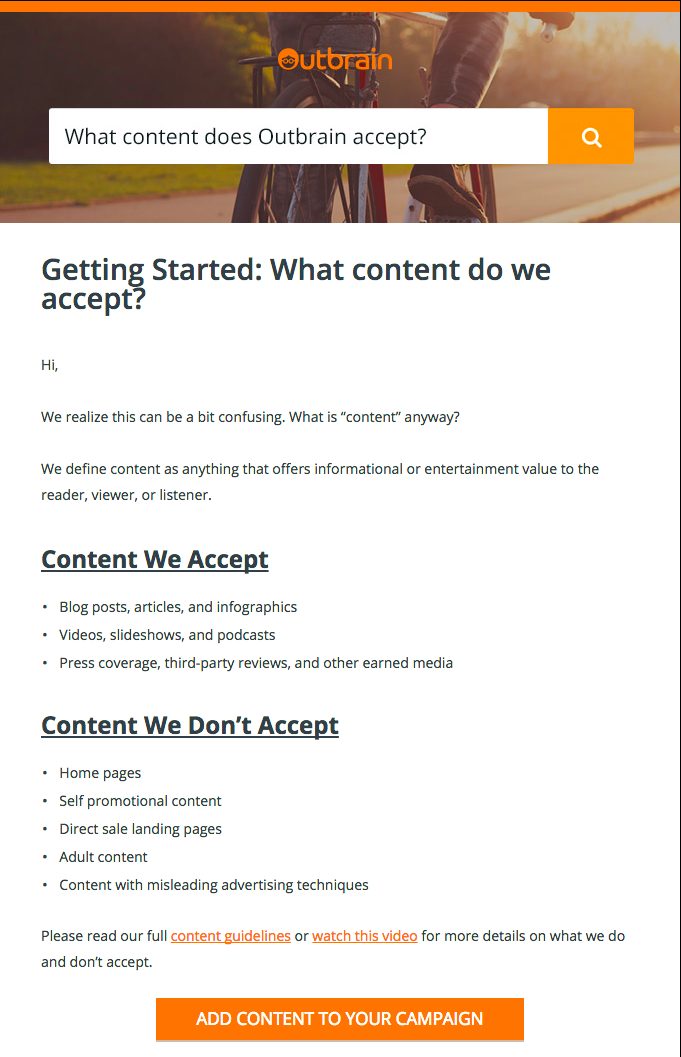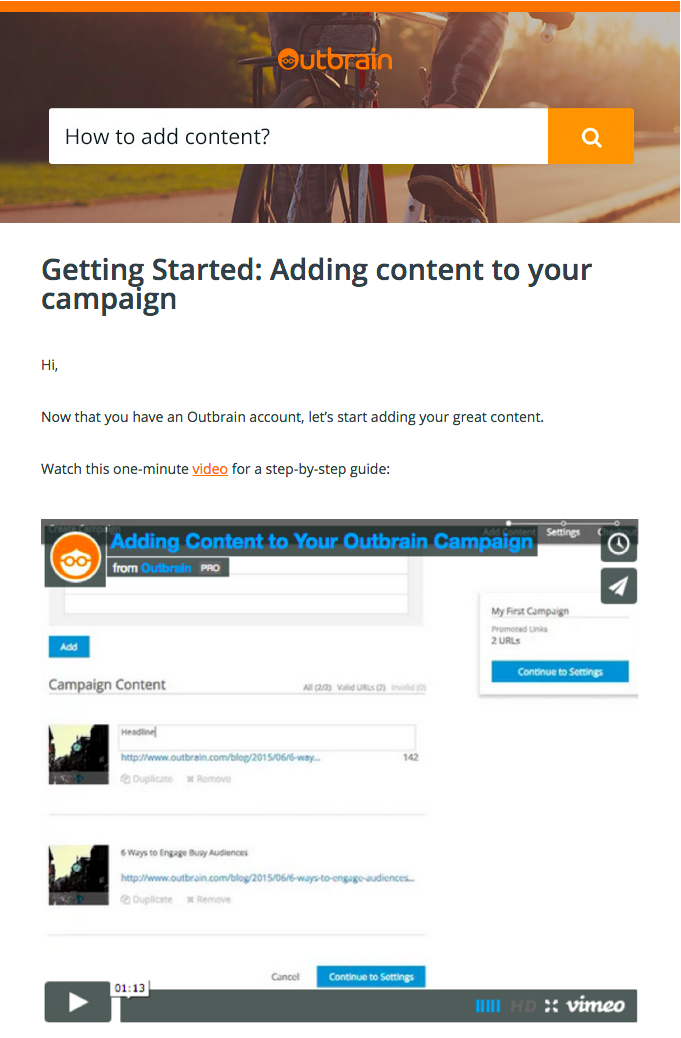Nurturing Your Funnel Dropouts: An Outbrain Email Case Study

When you were in college, you probably referred to dropouts as the kids in your class who didn’t finish their course of study.
In the industry, marketers identify dropouts as users who register for your products or services but abandon ship right before they’ve finalized a purchase or completed a checkout.
Dedicated enough to share their personal information (which is half the battle), something went awry, creating a wedge between becoming a customer and remaining a lead.
Even if you don’t have all the answers as to why, the worst thing you can do with these users is let them go without a fight.
In fact, according to Business insider, “approximately $4 trillion worth of merchandise will be abandoned in online shopping carts this year, and about 63% of that is potentially recoverable.”

As the Conversion Optimization Manager at Outbrain, I live this stuff every day. Hopefully by the end of this post you too will be ready to capitalize on this amazing opportunity.
3 Reasons Why Nurturing Funnel Dropouts is Worth the Investment
1. Sunk cost – You’ve already invested time, money and resources into getting these users to visit your site and educating them about your business. Now it’s time to get them over the goal line.
2. Warm leads – It’s challenging to target the right audience for your product and win their attention, and guess what? You did it! These leads are clearly interested. Some of them might have gotten all the way to checkout. Just one little push and you can win them back as customers.
3. Easy to solve issues – 25% of users leave without buying simply because they encountered a technical difficulty while on the website (navigation issues, site timeouts, etc). You can save a large share of those users by addressing some of those easy obstacles, as well as iron out any product misunderstandings through the help of great support.
Crafting the Right Message to Funnel Dropouts
Now that you are inspired about the idea of getting dropouts back on track, you should start thinking about the best way to do so.
There are all sorts of ways to reach out to this group of potentials.
You could create a one-off email offering support, send a discount or build an automated email flow to tackle various issues a user may have experienced along the way.
Take some time to experiment and find the right way for your business.
Whatever you end up deciding, here are three main components that I highly recommend including in your message:
1. We appreciate your interest. Let the user know they are seen and welcome them to your site. Be genuinely interested in what didn’t work out for them and why they left without achieving what they came in for. Opening that line of communication works like magic.
2. We are here to help. Every product or funnel has its soft spots, things that are often misunderstood and popular mishaps. This is a great time in the user’s journey to simplify the process and help clarify the issues with support.
3. Here’s all that you’ll be missing out on. Some users are just not ready to buy or aren’t sure your product or service is what they’re looking for. Make sure to remind them of what they can achieve by signing up. Tap into what made the user interested in your solution in the first place. Mention 3-5 benefits or features that make your product a must have in order to soothe their fears and insecurities or to meet their needs.
Outbrain Use Case: Activating Funnel Dropouts via Email
With thousands of new dropouts a month, we decided to setup an automated email flow to help activate users who entered our Amplify funnel but didn’t quite make it through to creating a content campaign.
Considering the right length for this flow, we thought a week would be enough time to communicate our messages without burdening the user, and went on to develop a week-long flow consisting of seven daily emails.
Following the three golden components mentioned above, emails were framed by an opening welcome email and a closing survey email. All emails in between were dedicated to providing the greatest assistance possible on the most burning questions and issues a user might experience during the pre-campaign stage.
Email 1: Welcome
Remember these are warmish leads that might just need a small nudge.
Enter stage right, the welcome email.
*Applause*
Sent around 24 hours after the user has left the funnel (if you can send it right after the user dropped off, even better), it has the greatest chance of bringing the user back.
No wonder it’s the best performing email in our flow, accounting for 56% of signups.
In this email, the user is reminded of the main things they can achieve by opening an Outbrain content campaign (or all they’ll be missing if they don’t).
We don’t worry too much about the features or benefits here, instead, we keep testing different variations to see which motivated the user best.
|
|
Email 2: Content Guidelines
Outbrain’s content guidelines help define what content can and cannot be promoted across our publisher’s network. It not only serves to distinguish us in a crowded marketplace but also streamlines the content submission process.
Two main reasons we tackled this:
-
To reduce the number of users signing up to find out their campaign wasn’t approved because it didn’t meet our content guidelines.
-
To reduce support tickets by offering better education around our content guidelines.
Can you think of anything similar that relates to your service or product? If so, consider including it when you reach out to dropouts.
|
|
Email 3-6: “Getting Started” A Step-by-Step Guide to Our Funnel
Consider this scenario:
We had an interested user. So interested they put in the effort to register for an Outbrain account and adding a URL(s) to start a content campaign.
However, we lost him somewhere along that process (the funnel).
Any chance something in the funnel caused it?
You bet!
But where the funnel may not have succeeded, your email flow can. Because all of the additional bite-sized information you couldn’t fit into earlier conversion stages can be supplied here.
Each four of our “Getting started” emails focuses on a different feature the user has to set when creating a campaign – Adding content, defining a budget and duration, targeting options and billing settings.
Included in the emails are short, less than two minute videos with bullet points to help sharpen the message we want users to take away.
|
|
Two main reasons we tackled this:
1. Funnels are not always easy, especially for somewhat complex products. In our case, building a content campaign can be intimidating if you aren’t living and breathing things like CPC, geo-targeting and conversion pixels. If people drop out, it’s possible there was something they didn’t quite understand, and a short, clear explanation can easily fix that.
2. 70% of users who drop out say they needed more info about the product. Through explaining the different steps in creating a content campaign, we actually explain more of the product and how everything works together. We found that doing so reduces uncertainty and helps users commit to the product.
Email 7: Survey
Like most things in life and marketing, everything you do is a learning process, and you should keep striving to get better.
Who better to teach you about your site and funnel experience than real users who have demonstrated an interest in your products and services but didn’t end up as a customer?
No one! So use the opportunity wisely.
Our email survey is six questions long and it uncovers what the user was hoping to achieve with Outbrain, what might have gone wrong, and an evaluation of the email flow they were just a part of.
One main reason to add a survey:
You really do learn a lot from user feedback.
In our case, we found out what made users drop out, which then played a huge role in developing this email flow and all of the content within it.
Don’t Forget
If you decide to build an email flow, you should make sure to include:
CTA
Add a CTA to each of the emails you build. Sounds all too logical, but is often overlooked. The CTA should take the user back to the funnel where they can easily complete the process. If you can
bring them back to where they left off – all the better.
Control group
Your flow is live and it’s doing AMAZING, but how can you be sure the dropouts who came back did so because of the email flow? The solution is to set up a control group of 10% of the users that will not receive the emails. See how that group converts compared to those who do get the emails and you will have your answer.
Tracking
This one may be technically challenging, but you should do your best to track every link, video or CTA you put in your emails. You will want to know which email performs best and worst, if your videos get played or distract the user, and which of the links brings the most conversions. If it can lead to a conversion – it should be tracked.
Proper Direction
When you add links that direct users to pages outside of the email (videos, blog, help center, etc.) you are basically shooting yourself in the foot. Here’s why: The emails above include a short video guide–with the purest of intentions, we almost sent recipients away from an email that included a CTA back to the funnel. With no easy way to convert on a standard “help” page without a CTA, we learned to think long and hard about what actions we want users to take and how to get them there.
Additional solution:
Keep the user in the same environment as the email.
We built a dedicated landing page for each of the videos we were looking to share. It was designed very thinly and only included the video and a CTA (same as the email) with zero distractions to keep users from converting.
Conclusion
In the end, it’s about not abandoning the users who abandoned you.
Chances are, it wasn’t really their fault (I’m looking at you, now).
With a little bit of TLC and some smart communication tactics, you can not only prove the ROI of your initiatives, and then some, but also build a loyal customer base.
Why?
Simply because you made it about them and contributed to their experience instead of detracting from it by leaving them stranded.
I hope some of the tips I’ve shared for nurturing your users come in handy along the way, and if you have any additional advice, feel free to leave us a comment!




